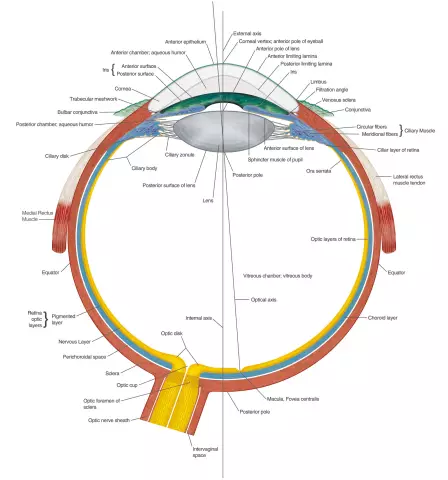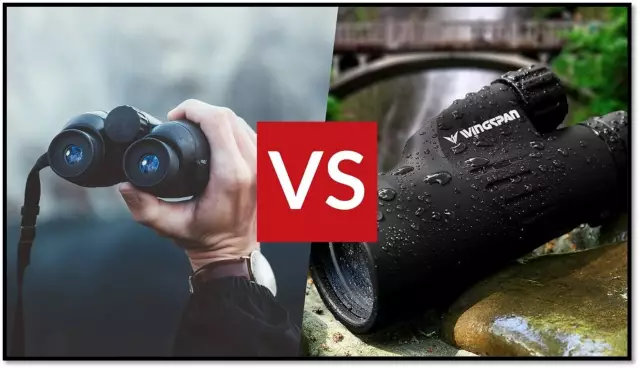- Author Curtis Blomfield [email protected].
- Public 2023-12-16 20:44.
- Last modified 2025-01-23 17:01.
Vision is vital to most living organisms. It helps to correctly navigate and respond to the environment. It is the eyes that transmit about 90 percent of the information to the brain. But the structure and placement of the eyes of different representatives of the living world is different.
What kind of vision is there
The following types of vision are distinguished:
- panoramic (monocular);
- stereoscopic (binocular).
With monocular vision, the surrounding world is perceived, as a rule, with one eye. This type of vision is typical mainly for birds and herbivores. This feature allows you to notice and respond to the impending danger in time.

Stereoscopic vision is inferior to panoramic vision with less visibility. But it also has a number of advantages, one of which is a three-dimensional image.
Distinctive features of stereoscopic vision
Stereoscopic vision is the ability to see the world around with two eyes. In other words, the overall picture is made up of a merger of images entering the brain from each eye at the same time.
With this type of vision, you cancorrectly estimate not only the distance to the visible object, but also its approximate size and shape.

Besides this, stereoscopic vision has another significant advantage - the ability to see through objects. So, if you place, for example, a fountain pen in a vertical position in front of your eyes and look alternately with each eye, then a certain area will be closed in both the first and second cases. But if you look with two eyes at the same time, then the pen ceases to be a hindrance. But this ability to "look through objects" loses its power if the width of such an object is greater than the distance between the eyes.
The peculiarity of this type of vision in various representatives of the globe is presented below.
Features of the structure of the eyes of insects
Their vision has a unique structure. The eyes of insects look like a mosaic (for example, the eyes of a wasp). Moreover, the number of these mosaics (facets) in different representatives of this representative of the living world differs and ranges from 6 to 30,000. Each facet perceives only part of the information, but in total they provide a complete picture of the surrounding world.

Insects perceive colors differently than humans. For example, a red flower that a person sees, the wasp's eyes perceive as black.
Birds
Stereoscopic vision in birds is the exception rather than the rule. The fact is that most birds have eyes located on the sides, which provides a wider viewing angle.
This type of vision is inherent mainly in birds of prey. This helps them correctly calculate the distance to moving prey.
But the visibility of birds is much less than, for example, people. If a person is able to see at 150°, then birds are only from 10° (sparrows and bullfinches) to 60° (owls and nightjars).
But do not rush, arguing that the feathered representatives of the living world are deprived of the ability to fully see. Not at all. The thing is, they have other unique features.

For example, owls have eyes closer to their beaks. In this case, as already noted, their viewing angle is only 60 °. Therefore, owls are only able to see what is directly in front of them, and not the situation to the side and behind. These birds have another distinctive feature - their eyes are motionless. But at the same time they are endowed with another unique ability. Thanks to the structure of their skeleton, owls are able to turn their heads 270°.
Pisces
As you know, in the vast majority of fish species, the eyes are located on both sides of the head. They have monocular vision. The exception is predatory fish, especially hammerhead sharks. For many centuries, people have been interested in the question of why this fish has such a head shape. A possible solution was found by American scientists. They put forward the version that the hammerhead fish sees a three-dimensional image, i.e. she is endowed with stereoscopic vision.
To confirm their theory, scientists conducted an experiment. To do this, on the heads of several species of sharks were placedsensors that measured the activity of the brain activity of fish when exposed to bright light. The subjects were then placed in an aquarium. As a result of this experience, it became known that the hammerhead fish is endowed with stereoscopic vision. Moreover, the accuracy of determining the distance to the object is the more accurate, the greater the distance between the eyes of this species of shark.
In addition, the hammerhead fish's eyes are known to rotate, allowing it to see its surroundings in full. This gives her a significant advantage over other predators.
Animals
Animals, depending on the species and habitat, are endowed with both monocular and stereoscopic vision. For example, herbivores that live in open spaces, in order to preserve their lives and quickly respond to impending danger, must see as much space around them as possible. Therefore, they are endowed with monocular vision.

Stereoscopic vision in animals is typical for predators and inhabitants of forests and jungles. First, it helps to correctly calculate the distance to its victim. The second such vision allows you to better focus your eyes among many obstacles.
So, for example, this type of vision helps wolves with long-term pursuit of prey. Cats - with a lightning attack. By the way, it is in cats that, thanks to parallel visual axes, the viewing angle reaches 120 °. But some breeds of dogs have developed both monocular and stereoscopic vision. Their eyes are located on the sides. So,to view an object at a great distance, they use frontal stereoscopic vision. And to view nearby objects, dogs are forced to turn their heads.

Inhabitants of the treetops (primates, squirrels, etc.) have stereoscopic vision in search of food and in calculating the trajectory of the jump.
People
Stereoscopic vision in humans has not been developed since birth. At birth, babies cannot focus on a particular object. Binocular vision in them begins to form only at 2 months of age. However, in full, children begin to correctly orient themselves in space only when they begin to crawl and walk.
Despite their apparent identity, human eyes are different. One is the leader, the other is the follower. For recognition, it is enough to conduct an experiment. Place a sheet with a small hole at a distance of about 30 cm and look through it at a distant object. Then alternately do the same, covering either the left or the right eye. The position of the head must remain constant. The eye for which the image does not change position will be the leading one. This definition is important for photographers, videographers, hunters and some other professions.
The role of binocular vision for humans
This type of vision arose in humans, as in some other representatives of the living world, as a result of evolution.
Certainly, modern humans don't need to hunt prey. However, stereoscopicvision plays a significant role in their lives. It is especially important for athletes. So, without an accurate calculation of the distance, biathletes will not hit the target, and gymnasts will not be able to perform on the balance beam.
This type of vision is very important for professions that require an instant reaction (drivers, hunters, pilots).

And in everyday life one cannot do without stereoscopic vision. For example, it is quite difficult, seeing with one eye, to put a thread into the eye of a needle. Partial loss of vision is very dangerous for a person. Seeing with only one eye, he will not be able to correctly navigate in space. And the multifaceted world will turn into a flat image.
Obviously, stereoscopic vision is the result of evolution. And only the elect are endowed with it.






